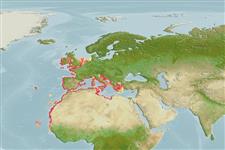Common names from other countries
>
Carangiformes (Jacks) >
Carangidae (Jacks and pompanos) > Naucratinae
Etymology: Campogramma: Greek, kampe, -es = curvature, bent + Greek, gramma = mark, signal, letter (Ref. 45335).
More on author: Lacepède.
Environment: milieu / climate zone / depth range / distribution range
Ökologie
seewasser benthopelagisch; tiefenbereich 15 - 30 m (Ref. 7097). Subtropical; 56°N - 12°N, 26°W - 27°E
Eastern Atlantic: British Isles to Senegal including Madeira and the Canary Islands. Also western Mediterranean Sea.
Size / Gewicht / Alter
Maturity: Lm ? range ? - ? cm
Max length : 60.0 cm FL Männchen/unbestimmt; (Ref. 3397); common length : 58.0 cm TL Männchen/unbestimmt; (Ref. 3397); max. veröff. Gewicht: 2.8 kg (Ref. 27584)
Rückenflossenstacheln (insgesamt) : 7; Rückenflossenweichstrahlen (insgesamt) : 30; Afterflossenstacheln: 2; Afterflossenweichstrahlen: 23 - 24.
Caught with bottom and pelagic trawls. Adults are pelagic or epibenthic (Ref. 7097) mostly in shallow waters. They feed mainly on schooling fishes (Ref. 4233). Eggs are pelagic (Ref. 4233).
Life cycle and mating behavior
Maturities | Fortpflanzung | Spawnings | Egg(s) | Fecundities | Larven
Smith-Vaniz, W.F., 1986. Carangidae. p. 815-844. In P.J.P. Whitehead, M.-L. Bauchot, J.-C. Hureau, J. Nielsen and E. Tortonese (eds.) Fishes of the north-eastern Atlantic and the Mediterranean. UNESCO, Paris. vol. 2. (Ref. 4233)
IUCN Rote Liste Status (Ref. 130435)
CITES (Ref. 128078)
Not Evaluated
Bedrohung für Menschen
Harmless
Nutzung durch Menschen
Can't connect to MySQL database (fbapp). Errorcode: Too many connections
